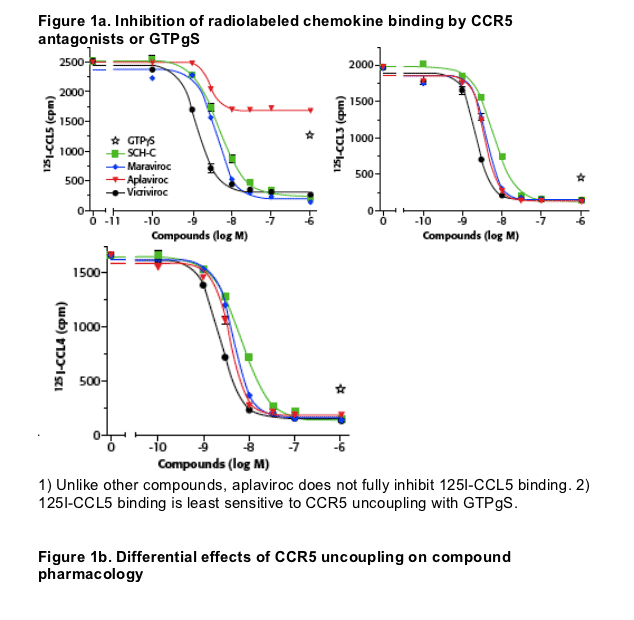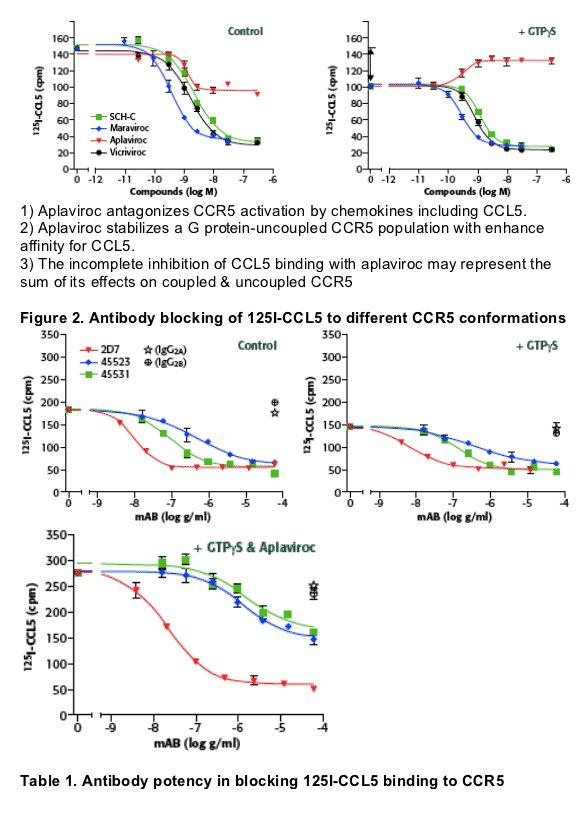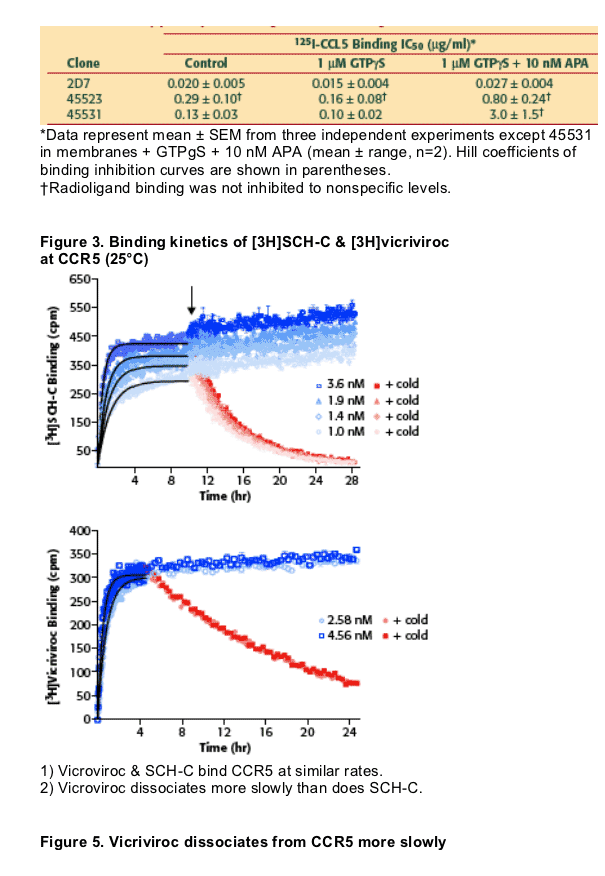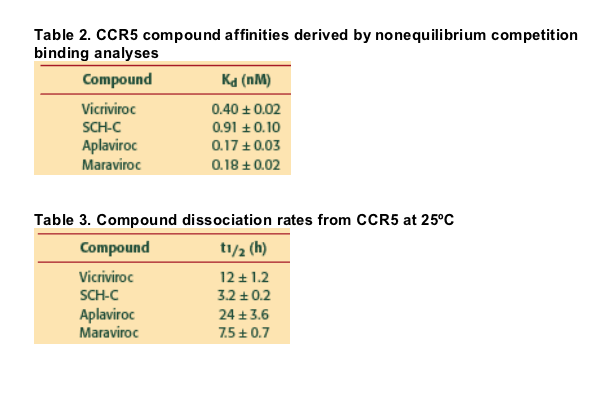 |
 |
 |
| |
Analysis of CCR5 Binding Kinetics and Coupling States Reveals Distinctive Binding Properties of Small Molecule CCR5 Antagonists
|
| |
| |
Reported by Jules Levin
ICAAC Sept 2006
Waldemar Gonsiorek, Julie M. Strizki, David Hesk, Daniel Lundell, and R. William Hipkin* Schering-Plough Research Institute, Kenilworth, New Jersey
AUTHOR CONCLUSIONS
1) Aplaviroc enhances CCL5 binding to G protein uncoupled receptor conformation(s) but inhibits CCL5 binding to coupled CCR5 (i.e. functional antagonist).
2) aCCR5 2D7 (but not 45523 and 45531) appears to bind competitively with CCL5 at different CCR5 conformations.
3) Vicriviroc dissociates from CCR5 -two-fold more slowly than does maraviroc.
Increased binding persistence is a pharmacodynamic advantage in
maintaining adequate receptor occupancy.
ABSTRACT
Background:
Blocking HIV-1 infection by targeting CCR5 has proven a valid strategy and several small molecule CCR5 inhibitors are in clinical development. Although these compounds all block HIV infection, differences in their CCR5 binding properties have been reported.
Methods:
We used a variety of nonequilibrium binding analyses with tritiated small molecules and radiolabeled chemokines to differentiate the pharmacology of SCH-C, maraviroc, aplaviroc and vicriviroc.
Results:
Binding analyses at ambient temperatures with [3H]SCH-C and [3H]vicriviroc showed that vicriviroc dissociates from CCR5 at a slower rate (t1/2 = 12 ± 1.2h) than does maraviroc (t1/2 = 7.5 ± 0.7h) even though maraviroc binds CCR5 with slightly higher affinity (vicriviroc Kd = 0.40 ± 0.02 nM; maraviroc Kd = 0.18 ± 0.02 nM). Under these conditions, aplaviroc dissociates from CCR5 more quickly (t1/2 = 24 ± 3.6h at 22C) than had been previously reported (t1/2 3 136h at 4C). All the CCR5 antagonists blocked CCR5 activation by CCL3, CCL4 and CCL5 and inhibited radiolabeled chemokine binding with the exception of aplaviroc, which did not completely displace 125I-CCL5. We investigated the consequence of CCR5 coupling state on compound pharmacology and showed that aplaviroc enhanced CCL5 binding to CCR5 uncoupled from its G protein tranducers.
Conclusions:
1) Vicriviroc, maraviroc and aplaviroc bind CCR5 with sub-nM affinity;
2) aplaviroc blocks CCL5 binding to coupled CCR5 while enhancing CCL5 binding to a G protein-uncoupled receptor conformation and
3) vicriviroc dissociates from CCR5 -two-fold more slowly than does maraviroc, a
factor which may provide a pharmacodynamic advantage in maintaining adequate receptor occupancy during therapy.
METHODS
I. Cell membranes
HTS-hCCR5 cell membranes were purchased from Stratagene.
II. Competition binding assays
Binding inhibition studies with radioloabeled MIP-1a (CCL3), RANTES (CCL4), MIP-b (CCL5) (Perkin-Elmer) were performed as previously described using SPA technology (Strizki et al. 2005).
III. The binding kinetics of [3H]SCH-C and [3H]vicriviroc
HTS-CCR5 membranes prebound to WGA-SPA beads were incubated with the indicated concentrations of [3H]SCH-C or [3H]vicriviroc in the absence or presence of excess unlabeled compound (total and nonspecific binding, respectively). To determine radioligand binding dissociation constants, membranes and beads were further incubated with excess unlabelled
compound (1-10 mM) or the appropriate diluent and counted sequentially every 30 sec.
IV. Nonequilibrium competition binding analyses
CCR5 compounds (3-5 nM) were added concurrently with 3-5 nM [3H]SCH-C and [3H]vicriviroc to CCR5 membranes prebound to WGA-SPA beads and data collected over time for analysis to generate k1, k2 and Kd (k2/k1) binding constants for the unlabeled compounds (Motulsky and Mahan, 1984).
V. Direct measurement of the dissociation constants of unlabeled compounds
HTS-CCR5 membranes prebound to WGA-SPA beads were incubated at room temperature in binding buffer in the presence or absence of 200 nM SCH-C, vicriviroc, aplaviroc or maraviroc for 2h. The samples were then rapidly but extensively washed by centrifugation prior to incubation for the with 5-10 nM [3H]SCH-C or [3H]vicriviroc in the presence or absence of 1 mM SCH-C.
Specific binding (total - nonspecific binding) was then accrued sequentially at the indicated times and fit using a one phase exponential association equation. Data collected prior to steady-state binding in the absence of compound pretreatment were excluded from these analyses (i.e. the first 2h).
VI. Binding analyses
Binding IC50 and kinetic constants were calculated using GraphPad Prism Software (Intuitive Software for Science).
VII. Materials
Tritiated SCH-C/SCH-D was generated as previously described (Strizki et al. 2005). CCR5 compounds were synthesized by SPRI. Chemokines and antibodies were purchased from R&D (Minneapolis, MN).
RESULTS





|
| |
|
 |
 |
|
|